Thanks to funding from the Great Lakes Restoration Initiative, the University of Wisconsin-Superior’s Great Waters Research Collaborative (GWRC) recently completed a project designed to examine the suitability of current filtration technologies for ballast water treatment in the Great Lakes. Ballast water is held in tanks of ships to provide stability when travelling and may be taken aboard or released in a port when loading or unloading cargo.
The filters were tested in cold waters containing ice and were evaluated on their ability to remove living organisms and suspended solids from freshwater. The research achieved the intended goals and determined filter removal efficiencies for organisms in ballast water. Additionally, an issue was identified with the functionality of the filter cleaning apparatus. GWRC identified that the issue was a result of solids and sediments in the uptake water restricting movement of the cleaning nozzle, thus rendering the device unable to keep the required proximity to the filter screen.
One filter is also currently being tested on a U.S. flag ship as a part of the GWRC’s Great Lakes Ballast Water Research and Development Plan, v.6. During the 2024 shipping season, the shipping partner experienced technical malfunctions with the filter onboard their ship. GWRC was able to use the knowledge gained during the land-based test to assist the shipping partner in troubleshooting the issue. Upon inspection, the company determined that the nozzles were stuck in position with a larger gap than expected between the nozzles and screen. The proximity of the nozzle is a key factor in the self-cleaning mechanism of the screen, and essential in keeping the system flowing when ballasting.
The shipping company contacted the filter company which responded to the issue by creating a new nozzle with higher wear resistance and durability, as well as the ability to free itself from solids that disturb the movement of the nozzle in the proximity of the screen. This new nozzle will be incorporated into the vessel and tested during the 2025 season, allowing GWRC to collect data on filter effectiveness and how the redesign impacts operability.
Read the full technical report on the Minds @ UW website: Land-Based Evaluation of the Effectiveness of Filtration Technologies


